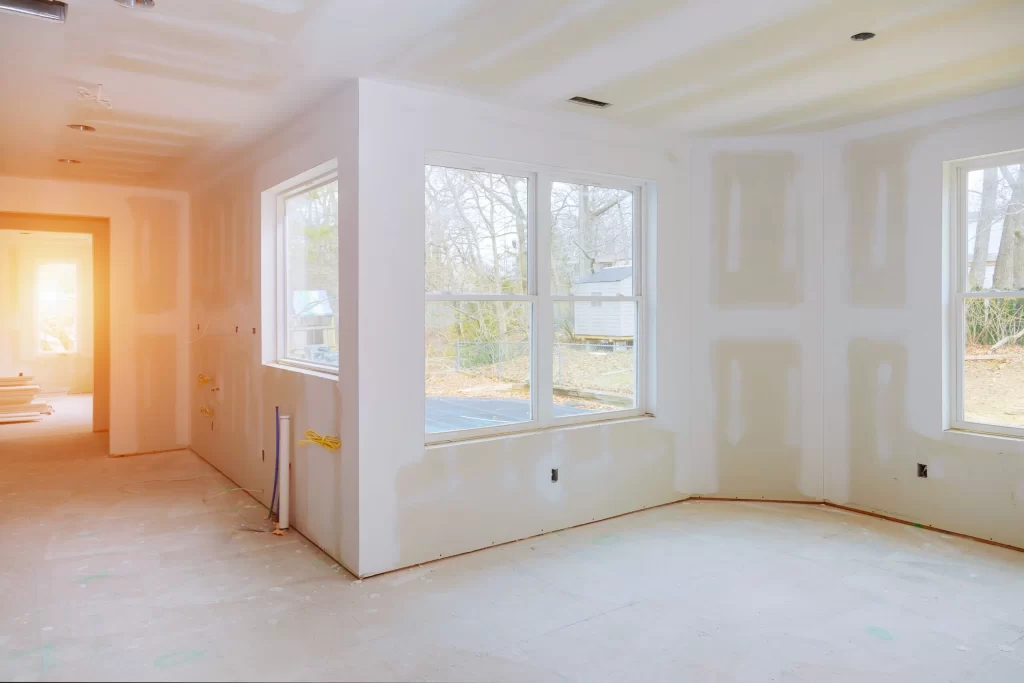Drywall properties and uses
Drywall is a construction material made of calcium sulfate dihydrate (gypsum). and it is commonly used for creating interior walls and ceilings in residential and commercial buildings. It is extruded between thick sheets of facer and backer paper. and it can be mixed with fiber, plasticizer, and foaming agent to create a durable and fire-resistant surface. Some of the key features of drywall include these.
Fiber. Typically made of paper, glass wool, or a combination of these materials. drywall adds strength and fire resistance to the surface.
Fire Resistance. Drywall is fire-resistant, helping to contain the spread of fire and improve safety during emergencies.

Speed of Installation. Drywall is quick and easy to install, requiring fewer specialized tools and less time compared to traditional plaster.
Cost-Effectiveness. Drywall is generally more cost-effective than other materials, such as plaster, and offers a smoother, more uniform appearance.
There are various types of drywall materials designed to meet specific needs. such as fire-resistant panels containing additional fibers and other fire-resistant materials. Drywall is also used to create many design features, including eaves, arches, and other architectural specialties. In large-scale construction, an entire house can be drywalled in one or two days by experienced drywallers. That’s making it an efficient and accessible option for both professionals and amateur home carpenters.
Different types of joint compound
There are different types of joint compounds used for drywall installation and finishing. The common types include these.
All Purpose Compound. All purpose joint compound is a versatile option suitable for various stages of drywall work, such as taping and finishing.
Taping Compound. Specifically used for the first two layers of a drywall project to fill in cracks and apply tape.
Topping Compound. Ideal for the final coating and finishing of drywall seams and corner beads. It is not recommended for taping joints.
Setting Compound. Also known as quick-setting compound or hot mud, this type sets and dries quickly, making it suitable for time-sensitive projects.
Lightweight All-Purpose Joint Compound. This type is lighter in weight than the standard all-purpose compound, making it easier to work with.
These compounds come in different forms, such as dry and pre-mixed, each with its own characteristics and uses.
The right joint compound for drywall projects
To choose the right joint compound for your drywall project, consider the following factors.
Type of project: Determine the scope of your project, such as taping, repairing, or finishing. Different types of joint compounds are suitable for different stages of the project.
Tape style: The type of tape you use will help you determine the appropriate joint compound. For example, mesh tape requires setting compound (quick-setting), while paper tape may require a different type of joint compound.
Drying time: Consider how fast you need the joint compound to dry. Setting compounds, also known as quick-setting compounds, dry quickly, making them suitable for time-sensitive projects.
Texture: Some joint compounds, like topping compounds, are “soupy” and contain less adhesive than all-purpose compounds. They may have a different texture than what you’re used to.
Sandability: All-purpose joint compound offers a good all-around mix of hardness, ease of working, and sandability. making it a popular choice for many projects.
Adhesion: Some joint compounds, like setting compounds, provide better adhesion for mesh tape compared to other types of joint compounds.
Cost: Consider your budget when choosing a joint compound. Some all-purpose joint compounds may be more expensive than other types. but they offer additional benefits, such as easier sanding and better adhesion.
Based on these factors, you can select the appropriate joint compound for your drywall project. Remember to follow the manufacturer’s instructions and recommendations for the best results.
Common mistakes to avoid when using joint compound
When using joint compound, there are common mistakes to avoid.
Using the wrong consistency. Ensure the joint compound has a good consistency and avoid using it when it’s too thick or thin.
Applying too much mud. Excessive application of joint compound can lead to issues. such as bubbles forming, tape not sticking properly, and the need for more sanding.
Applying too much pressure. When pressing the compound, avoid applying too much pressure, as this can cause the tape to tear or move.
Not working on wet surfaces. Make sure to work on wet surfaces when applying joint compound, as it can lead to poor adhesion and cracking.
Ignoring the manufacturer’s instructions. Always follow the manufacturer’s instructions and recommendations for the best results.
Not priming the surface. If the joint compound is lightweight, it may be more susceptible to scratches. Applying a coat of primer can help protect the surface and improve the finish.
By avoiding these common mistakes, you can ensure a smoother and more successful drywall project.
